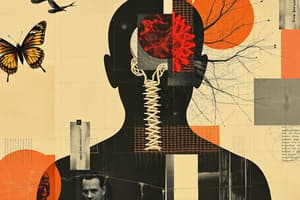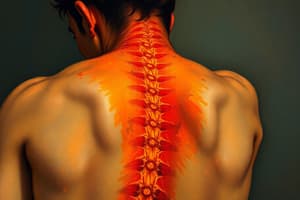Podcast
Questions and Answers
What is the role of receptors in response to stimuli?
What is the role of receptors in response to stimuli?
- They exclusively transmit pain signals.
- They detect stimuli and alter their state. (correct)
- They block ion flow across the membrane.
- They inhibit the action potentials.
Which type of receptors respond to mechanical forces?
Which type of receptors respond to mechanical forces?
- Ligand-gated receptors
- Mechanically-gated receptors (correct)
- Nociceptors
- Voltage-gated receptors
Which statement about nociceptors is true?
Which statement about nociceptors is true?
- They exclusively detect pain from mechanical forces.
- They are present in all organs.
- They only respond to temperature changes.
- They can respond to mechanical, chemical, and temperature stimuli. (correct)
How does an action potential begin in a receptor?
How does an action potential begin in a receptor?
What characterizes G-protein coupled receptors?
What characterizes G-protein coupled receptors?
What is the primary function of nociceptive pain?
What is the primary function of nociceptive pain?
Which of the following is NOT a step in the process of nociception?
Which of the following is NOT a step in the process of nociception?
What type of stimuli can nociceptive pain encode?
What type of stimuli can nociceptive pain encode?
Nociceptive pain is characterized as which type of pain?
Nociceptive pain is characterized as which type of pain?
Which statement best describes modulation in the context of nociception?
Which statement best describes modulation in the context of nociception?
Which of the following correctly contrasts nociceptive and neuropathic pain?
Which of the following correctly contrasts nociceptive and neuropathic pain?
What occurs during the transduction phase of nociception?
What occurs during the transduction phase of nociception?
Which of these emotions is commonly associated with pain experiences?
Which of these emotions is commonly associated with pain experiences?
Study Notes
Session Learning Outcomes
- Ability to describe the process of transduction and transmission of nociceptive stimuli.
- Understanding modulation of nociceptive signals.
- Distinction between nociceptive pain and neuropathic pain.
Definition of Pain
- Pain is defined as an unpleasant sensory and emotional experience related to actual or potential tissue damage.
- Functions as a protective mechanism and a critical learning tool.
- Pain evokes strong emotional responses.
Biological Perspective on Pain
- Pain originates from brain function, encompassing both sensation and perception.
Types of Pain
-
Nociceptive (Acute) Pain:
- Known as 'physiologic pain'; serves a protective purpose.
- Alerts the body to problems and prevents further injury.
- Aids healing by promoting rest.
-
Neuropathic Pain:
- Pathophysiologic in nature; can cause harm.
Nociception
- Nociception involves the encoding of noxious stimuli into neural signals.
- Types of noxious stimuli include:
- Thermal: Extreme heat or cold.
- Mechanical: Physical pressure (e.g., pinching).
- Chemical: Irritants, including acids.
Steps of Nociception
- Comprises four steps:
- Transduction: Initial conversion to nerve signals.
- Transmission: Relaying signals through neural pathways.
- Perception: Briefly addressed; involves recognizing pain.
- Modulation: Adjusting the pain signals.
Historical Context
- René Descartes’ contributions to the understanding of pain date back to 1664.
Modern Context
- Viewed as a complex interaction involving nociception, pain perception, negative moods, and behavior selection with a focus on transmission and modulation.
Transduction Process
- Transduction involves converting different energy forms into nerve signals.
- Key stimuli types include temperature, mechanical, and chemical stimuli leading to action potentials.
Role of Receptors in Transduction
- Specialized proteins (receptors) detect stimuli and undergo changes that lead to ion flow across membranes inducing action potentials.
- Receptors are critical targets for drug action.
Types of Receptors
- Various receptor types:
- Ligand-gated: Respond to specific chemicals.
- Voltage-gated: Open in response to changes in membrane potential.
- Mechanically-gated: Activate due to physical changes.
- G-protein coupled receptors: Intracellular signaling.
Nociceptors
- Free nerve endings found in somatic and visceral structures.
- Not all organs possess nociceptive innervation.
- Respond to various stimuli: temperature, mechanical force, and chemicals.
- Examples of receptors:
- TRPV1: Sensitive to heat above 42 ºC.
- TRPM8: Sensitive to cold stimuli.
Studying That Suits You
Use AI to generate personalized quizzes and flashcards to suit your learning preferences.
Description
This quiz explores the definitions and biological perspectives of pain, focusing on the mechanisms of nociceptive and neuropathic pain. Learn about the processes of transduction and transmission of nociceptive signals and how they differ from neuropathic pain. Perfect for those studying pain management and neuroscience.




